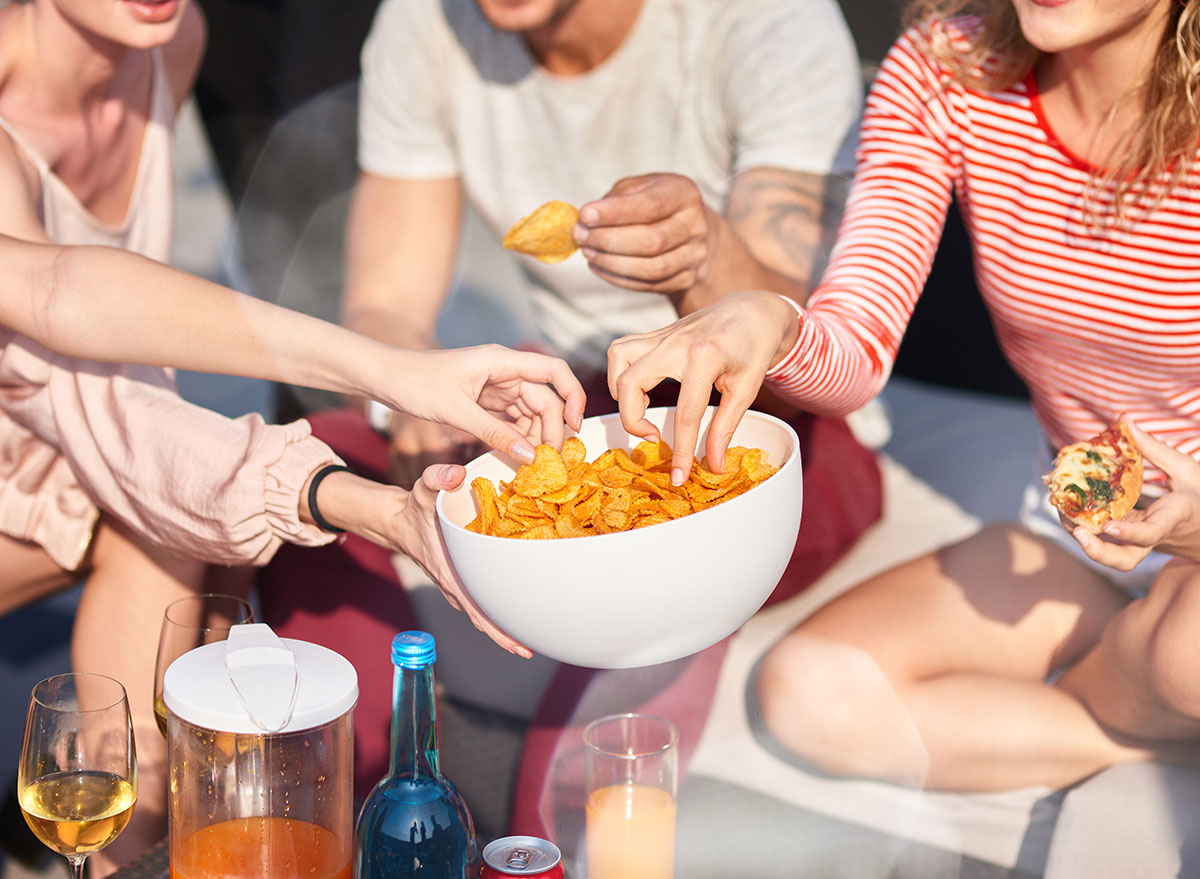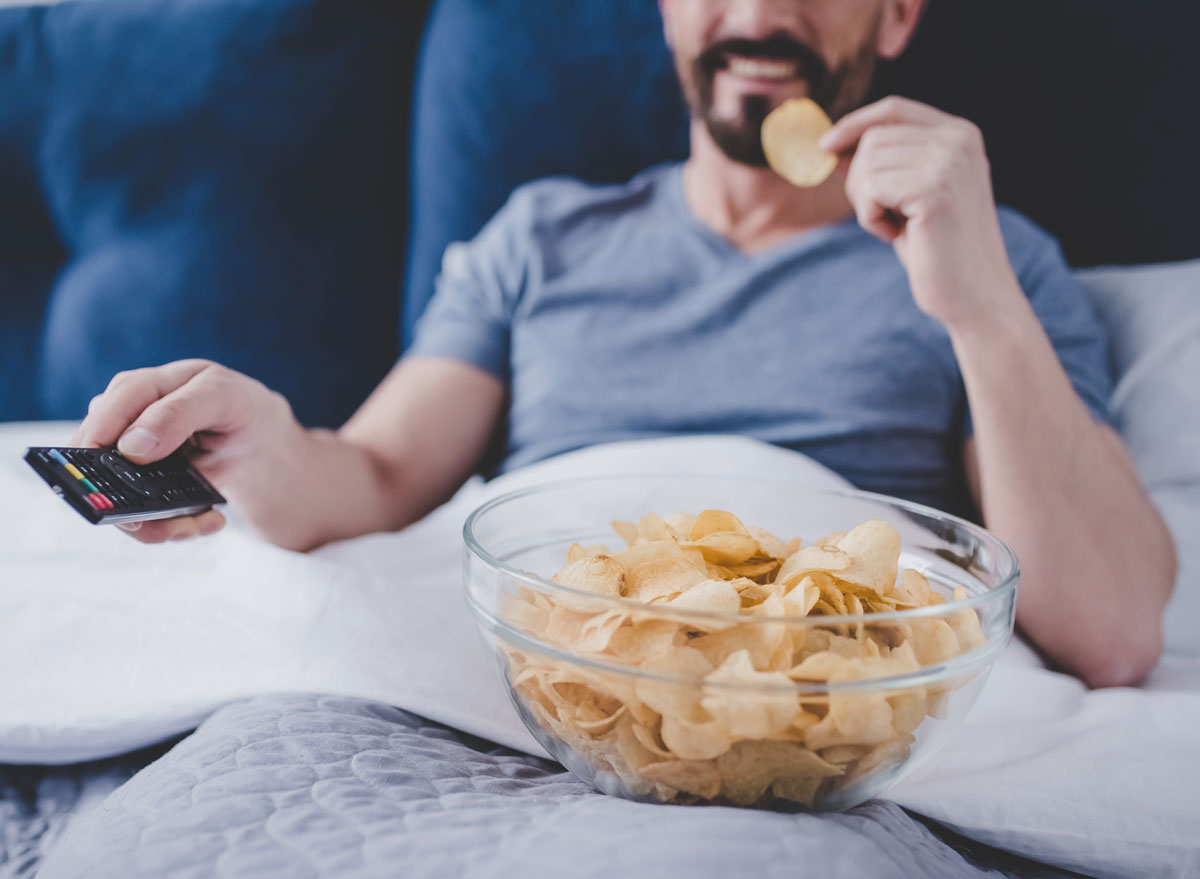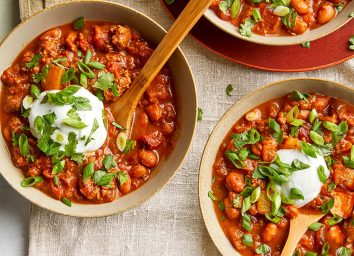
Super Bowl is just hours away and the clock is ticking until the kickoff begins.
Along with cheering and singing along with the halftime show, chances are you'll also be munching away on delectable finger foods. After all, the National Retail Federation predicts that 77% of the $13.9 billion Americans are projected to spend on game day festivities will go toward food and beverages. (Related: 100 Easiest Recipes You Can Make).
The number one item that is likely to be on the menu in households everywhere? Chicken wings. According to the National Chicken Council, Americans are expected to feast on a record-breaking 1.42 billion wings this Sunday. While the more health-conscious game lovers may be enjoying their wings either grilled or air fried, millions will be indulging in traditional favorites, such as buffalo (aka deep-fried) wings and BBQ wings. The main appetizer will be accompanied by several other comfort food classics including loaded nachos, loaded fries, creamy dips, chips, pizza, chili, sliders, subs, pulled pork, potato skins, and pigs in a blanket.
Some type of dessert—perhaps brownies or cupcakes—may also be enjoyed around the third quarter while soda, beer, and cocktails are likely to be consumed throughout the entirety of the game. In short, your body is about to endure a massive indulgence, and we turned to the health experts to ask what you should prepare for this Sunday.
Read on to see five possible side effects that could occur from overindulging on Super Bowl Sunday. And then, don't miss the 19 Healthiest Snacks to Buy for the Super Bowl, According to Dietitians.
You may experience…
Bloating

The majority of cured meats, frozen apps, canned soups, chips and crackers, cheesy dips, dressings, BBQ sauce, and pizza have one major ingredient in common—sodium.
"One of the biggest short-term consequences of eating a lot of sodium is bloating and puffiness," says Amy Gorin, MS, RDN, a plant-based registered dietitian and owner of Plant-Based Eats in Stamford, Connecticut. Beware if you're ordering from your local deli or pizzeria, as she notes that restaurant dishes can contain more than half the daily value of sodium. For perspective, you should cap your sodium intake at 2,300 milligrams a day.
"Have you ever weighed yourself the morning after you ate a decadent takeout meal and wondered why the scale jumped up a few pounds? This is the aftereffect of consuming a lot of sodium," Gorin explains. Along with salt causing water retention, a 2019 study published in The American Journal of Gastroenterology found that excess sodium in the diet can alter the gut microbiome in such a way that can lead to bloating. (Related: More Than 70% of Your Daily Salt Intake Comes From These Foods.)
Simple Super Bowl Swap: If your belly feels swollen, Gorin suggests putting down the sub sandwich and snacking on potassium-rich foods, such as avocado and banana, to counteract the excess sodium.
Acid reflux

If you feel a burning sensation behind your breastbone after eating anything spicy or fried that's smothered in onions, you're likely experiencing heartburn. The American College of Gastroenterology estimates that more than 60 million Americans experience heartburn at least once a month, while more than 15 million men and women suffer from it daily. Heartburn results from acid reflux, which is when stomach acid flows back up into the esophagus.
"Heartburn can be triggered by eating large portions of foods, as well as eating triggering foods, such as tomatoes and drinking alcohol," Gorin says. A 2017 study conducted by medical researchers from Korea University Guro Hospital concluded that a portion of young adults who dealt with weekly bouts of gastroesophageal reflux disease (GERD) displayed symptoms (including heartburn, belching, and nausea) after eating hot spicy stews, rice cakes, ramen noodles, and fried foods.
Simple Super Bowl Swap: "If tomatoes are a trigger for acid reflux, make your own white pizza, like my recipe for caramelized onion and mushroom pizza," Gorin says.
Don't miss, It's Possible to Contract COVID Via Food and Drink If You Have This Condition, Study Says.
Migraine

While your head may be throbbing from losing money in the virtual office pool, there's also a chance that downing too much alcohol may be to blame for your pounding headache or migraine.
"For people with a sulfite sensitivity, having even half a glass of wine can cause nasty side effects, like a headache, dizziness, or even hives and itchiness," Gorin states. While triggers vary from person to person, the American Migraine Foundation lists artificial sweeteners, chocolate, processed meats, and foods containing MSG (such as fast food and chips), histamine (think, smoked meats), and tyramine (aged cheeses, pepperoni, and salami), along with red wine and beer as top offenders.
Also, a 2016 study published in the American Journal of Public Health shows that the risk of headache increases when sodium intake increases. Consuming an abundance of sodium can elevate blood pressure, which can, in turn, cause head pain.
Simple Super Bowl Swap: "If you're set on drinking wine yet have a sulfite sensitivity, it's best to choose lower-sulfite options such as organic, sustainable, or biodynamic wine," she says. "Also, consider trading in one or two of your alcoholic drinks for sparkling water. Not only will it help you hydrate, but it will also help you have less of a hangover the next day."
Another idea? Consider giving Drop It! a try—a portable product that removes headache-causing sulfites and tannins from wine without tampering with the flavor.
Elevated blood pressure levels

Blood pressure can skyrocket after devouring high-sodium snacks, such as wings, chips, and nachos.
"An increase in sodium in your bloodstream pulls water into your blood vessels, increasing the total amount or volume of blood inside them," says Katherine Brooking, MS, RD, founding partner of the nutrition marketing and communications firm AFH Consulting. "With more blood flowing through your blood vessels, blood pressure increases."
Sweet treats can also contribute to higher-than-normal blood pressure since research published in the journal Nutrients discovered an association between added sugars and systolic blood pressure (the first number) and diastolic blood pressure (the second number). Be sure to check out 13 Worst Foods for High Blood Pressure for ideas on which things to avoid eating this Sunday.
Simple Super Bowl Swap: Ditch the processed cheese dip for hummus, suggests Brooking. "Hummus offers a delicious package of nutrients that can improve the nutritional value of meals and snacks, especially when used in place of other calorie-laden spreads, toppings, or ingredients." (Her current go-to product is Sabra's Simple Roasted Pine Nut Hummus.) Also, instead of nibbling on salty chips or pretzels, Brooking snacks on pistachios. "Believe it or not, you can eat 49 pistachios in a serving, which comes out to about 160 calories."
A cardiac episode

Yes, heartburn and hypertension can have a direct impact on your cardiovascular health—but, in extreme cases, so can the actual game.
"Studies show that the stress of cheering on your favorite team can lead to heart attacks when your team loses or is behind," says Julie Upton, MS, RD, founding partner of the nutrition marketing and communications firm AFH Consulting. "The increase in heart attacks occur during, and up to several days after the game is over. And this explains why it's important to take a few deep breaths if you find yourself getting too worked up about the score, as well as to watch your intake of foods and beverages that can have an adverse impact on your heart, which includes alcohol and foods that contain excessive sodium, saturated fat, and added sugars."
Simple Super Bowl Swap: "In lieu of classic cookies or brownies, I love fruit-based desserts, such as fresh and dried fruits, like figs, strawberries, and apricots dipped in heart-healthy dark chocolate and sprinkled with chopped pistachios," Upton says.
For more ideas, be sure to check out Last Minute Beer and Food Pairings for Super Bowl Sunday.








